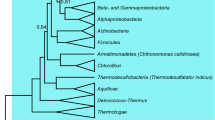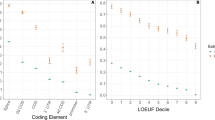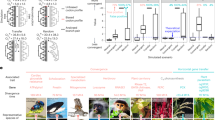Abstract
Arising from: J. B. Plotkin, J. Dushoff & H. B. Fraser Nature 428, 942–945 (2004); see also communication from Hahn et al.; Nielsen et al.; Plotkin et al. reply Plotkin et al.1 introduce a method to detect selection that is based on an index called codon volatility and that uses only the sequence of a single genome, claiming that this method is applicable to a large range of sequenced organisms1. Volatility for a given codon is the ratio of non-synonymous codons to all sense codons accessible by one point mutation. The significance of each gene's volatility is assessed by comparison with a simulated distribution of 106 synonymous versions of each gene, with synonymous codons drawn randomly from average genome frequencies. Here we re-examine their method and data and find that codon volatility does not detect selection, and that, even if it did, the genomes of Mycobacterium tuberculosis and Plasmodium falciparum, as well as those of most sequenced organisms, do not meet the assumptions necessary for application of their method.
This is a preview of subscription content, access via your institution
Access options
Subscribe to this journal
Receive 51 print issues and online access
$199.00 per year
only $3.90 per issue
Buy this article
- Purchase on Springer Link
- Instant access to full article PDF
Prices may be subject to local taxes which are calculated during checkout

Similar content being viewed by others
References
Plotkin, J. B., Dushoff, J. & Fraser, H. B. Nature 428, 942–945 (2004).
van Nimwegen, E., Crutchfield, J. P. & Huynen, M. Proc. Natl Acad. Sci. USA 96, 9716–9720 (1999).
Akashi, H. Curr. Opin. Genet. Dev. 11, 660–666 (2001).
Lynch, M. & Conery, J. S. Science 302, 1401–1404 (2003).
Hughes, A. L. & Verra, F. Proc. R. Soc. Lond. 268, 1855–1860 (2001).
Sreevatsan, S. et al. Proc. Natl Acad. Sci. USA 94, 9869–9874 (1997).
Author information
Authors and Affiliations
Additional information
Reply: J. B. Plotkin, J. Dushoff and H. B. Fraser reply to this communication (doi:10.1038/nature03224).
Rights and permissions
About this article
Cite this article
Chen, Y., Emerson, J. & Martin, T. Codon volatility does not detect selection. Nature 433, E6–E7 (2005). https://doi.org/10.1038/nature03223
Published:
Issue Date:
DOI: https://doi.org/10.1038/nature03223
This article is cited by
-
In Arabidopsis thaliana codon volatility scores reflect GC3 composition rather than selective pressure
BMC Research Notes (2012)
-
An insight into the sialotranscriptome of the West Nile mosquito vector, Culex tarsalis
BMC Genomics (2010)
-
Codon volatility of hemagglutinin genes of H5N1 avian influenza viruses from different clades
Virus Genes (2009)
-
Codon volatility does not detect selection (reply)
Nature (2005)
Comments
By submitting a comment you agree to abide by our Terms and Community Guidelines. If you find something abusive or that does not comply with our terms or guidelines please flag it as inappropriate.



